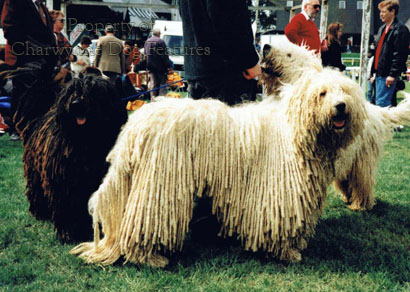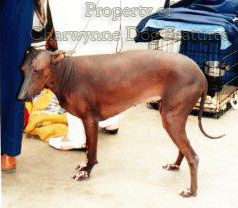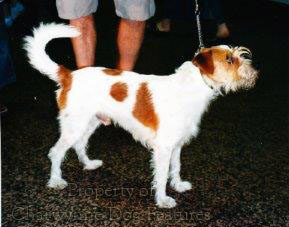191 Exotic Dogs
CANIS EXOTICUS
by David Hancock

 "Welcome to the Canine Zoo, ladies and gentlemen. On the left we have barkless dogs from the Belgian Congo and ridgebacked dogs from Thailand and Rhodesia. On the right we have dogs from the extreme north: Alaska, Siberia, Sweden, Finland, Norway and Arctic Canada. Ahead of you we have the oriental section, with dwarf dogs from Japan, China and Tibet. At the far end we have the EU area, with all the herding breeds of mainland Europe. Just around the corner is the freak show: abnormally hairy dogs from Hungary, hairless dogs from China and Mexico, dogs with virtually no legs, dogs with ears that drag on the ground, the heaviest mastiff in the world (it may be lying down because it cannot stand for more than a few minutes) and the tallest wolfhound in the world (please don't excite it, it has brittle bones). If you come again next year, you will be able to see our new museum of the extinct British breeds of dog, covering all those native breeds no longer fancied. Have a nice day!"
"Welcome to the Canine Zoo, ladies and gentlemen. On the left we have barkless dogs from the Belgian Congo and ridgebacked dogs from Thailand and Rhodesia. On the right we have dogs from the extreme north: Alaska, Siberia, Sweden, Finland, Norway and Arctic Canada. Ahead of you we have the oriental section, with dwarf dogs from Japan, China and Tibet. At the far end we have the EU area, with all the herding breeds of mainland Europe. Just around the corner is the freak show: abnormally hairy dogs from Hungary, hairless dogs from China and Mexico, dogs with virtually no legs, dogs with ears that drag on the ground, the heaviest mastiff in the world (it may be lying down because it cannot stand for more than a few minutes) and the tallest wolfhound in the world (please don't excite it, it has brittle bones). If you come again next year, you will be able to see our new museum of the extinct British breeds of dog, covering all those native breeds no longer fancied. Have a nice day!"

For those who respect dogs such a visitor attraction is an awesome prospect, but is it really unthinkable? Crufts Dog Show could already provide the material if not the approach. The 'Discover Dogs' section of Crufts mainly demonstrates breeds from abroad and the Kennel Club, unlike countries such as Japan and Denmark, has no in-house committee solely to promote and conserve our native breeds of dog. In times when we are importing tailless sheepdogs from Poland, huge herd protectors from Eastern Europe and cowdogs from Norway, we have lost old British breeds like the Welsh hillman, the Smithfield sheepdog, the Welsh grey and the Welsh black and tan sheepdog. We promote German breeds ahead of our own. We lose our own water dogs and then import those of Portugal, Italy and Spain. We neglect to preserve our own decoy dogs and then seem astounded to find them in former colonies, as the Nova Scotia Duck Tolling Retriever illustrates. Our admirable drovers' dog, the bobtail, is now best known from the television advertisement for paint. Does an island race have to look overseas before it can be satisfied? 

I welcome breeds from abroad and have written in praise of them many times. I am however strongly against the importation of extreme forms of the dog, the excessive favouritism shewn to really rather ordinary breeds from overseas and the neglect of our native breeds which this leads to. When a purebred dog of a breed new to this country is imported it contributes nothing to the genetic diversity in our dogs. In all breeds of purebred dogs registered with the Kennel Club the gene pool is closed. This is despite the benefits obtained in the Deerhound from an outcross to the Greyhound, in the Field Spaniel through an outcross to the English Springer, an outcross in miniature Bull Terriers to the bigger variety and in the Bernese Mountain dog from Newfoundland blood. A small gene pool in the hands of unskilled breeders is a recipe for disaster.

There is a worry too about new breeds from abroad with a small genetic base; they are full of 'genetic junk' and unhealthy dogs can so easily be produced from such stock. This brings good trade to the veterinary profession, but heartbreak for owners and distress to the afflicted dogs. In a free society, people should be able of course to import whichever breed of dog they wish to. But if that breed's imported specimens carry inherited defects and these are transmitted so as to constitute a defective breed, then that does need curtailing.
The creation of breeds or so-called breeds abroad has at times reached quite absurd proportions. The Kromfohrlander, the product of an accidental mating between a Fox Terrier and a small griffon, is now an internationally recognised breed. The Eurasier is a hybrid; the Russian Black Terrier a purpose-bred blend of several breeds, the Cesky Terrier arises from Sealyham stock, whilst our Sealyham fades from view. Coming soon to a pet shop near you could be Kyi-Leos, Munchkins, Mikis, Moscow Toy Terriers, Petersburg Orchids, Moscow Guard Dogs (from St Bernard blood) and the Japanese Shikoku. The Thai Ridgeback Dog is now selling well in the United States. Soon it will feature here, desired because it is exotic, rare and unusual not because of its characteristics.

I see plenty to admire in foreign breeds. Many have been introduced here for our and their benefit by worthy people. But I see nothing to admire in the fad importation of some exotic breed because it makes the new owner distinctive or feel so. We already have a huge problem in Britain of irresponsible dog ownership. We are hardly easing that problem when we import new breeds whose needs and characteristics are all but unknown to us. It is not our needs which we should be satisfying but those of admirable subject creatures like dogs.